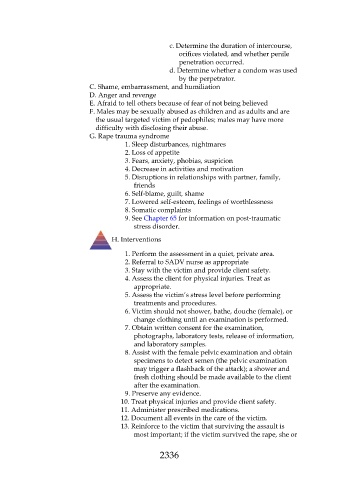Page 2336 - Saunders Comprehensive Review For NCLEX-RN
P. 2336
c. Determine the duration of intercourse,
orifices violated, and whether penile
penetration occurred.
d. Determine whether a condom was used
by the perpetrator.
C. Shame, embarrassment, and humiliation
D. Anger and revenge
E. Afraid to tell others because of fear of not being believed
F. Males may be sexually abused as children and as adults and are
the usual targeted victim of pedophiles; males may have more
difficulty with disclosing their abuse.
G. Rape trauma syndrome
1. Sleep disturbances, nightmares
2. Loss of appetite
3. Fears, anxiety, phobias, suspicion
4. Decrease in activities and motivation
5. Disruptions in relationships with partner, family,
friends
6. Self-blame, guilt, shame
7. Lowered self-esteem, feelings of worthlessness
8. Somatic complaints
9. See Chapter 65 for information on post-traumatic
stress disorder.
H. Interventions
1. Perform the assessment in a quiet, private area.
2. Referral to SADV nurse as appropriate
3. Stay with the victim and provide client safety.
4. Assess the client for physical injuries. Treat as
appropriate.
5. Assess the victim’s stress level before performing
treatments and procedures.
6. Victim should not shower, bathe, douche (female), or
change clothing until an examination is performed.
7. Obtain written consent for the examination,
photographs, laboratory tests, release of information,
and laboratory samples.
8. Assist with the female pelvic examination and obtain
specimens to detect semen (the pelvic examination
may trigger a flashback of the attack); a shower and
fresh clothing should be made available to the client
after the examination.
9. Preserve any evidence.
10. Treat physical injuries and provide client safety.
11. Administer prescribed medications.
12. Document all events in the care of the victim.
13. Reinforce to the victim that surviving the assault is
most important; if the victim survived the rape, she or
2336

